2008 Seat Ibiza 5D height
[x] Cancel search: heightPage 9 of 260
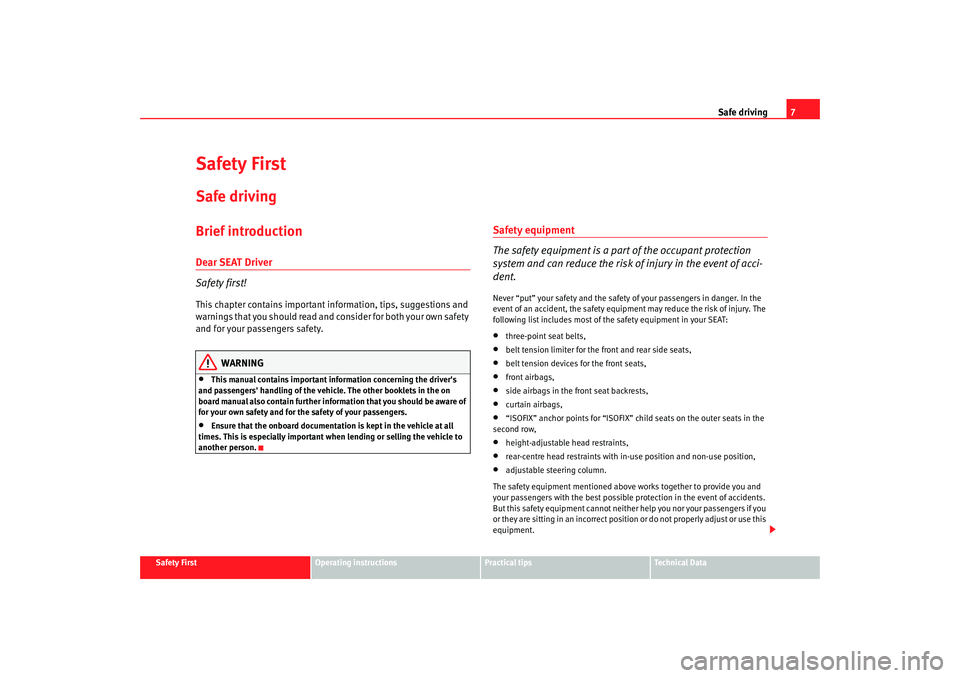
Safe driving7
Safety First
Operating instructions
Practical tips
Te c h n i c a l D a t a
Safety FirstSafe drivingBrief introductionDear SEAT Driver
Safety first!This chapter contains important information, tips, suggestions and
warnings that you should read and consider for both your own safety
and for your passengers safety.
WARNING
•
This manual contains important info rmation concerning the driver's
and passengers' handling of the vehicle. The other booklets in the on
board manual also contain further information that you should be aware of
for your own safety and for the safety of your passengers.
•
Ensure that the onboard documentatio n is kept in the vehicle at all
times. This is especially important when lending or selling the vehicle to
another person.
Safety equipment
The safety equipment is a part of the occupant protection
system and can reduce the risk of injury in the event of acci-
dent.Never “put” your safety and the safety of your passengers in danger. In the
event of an accident, the safety equipment may reduce the risk of injury. The
following list includes most of the safety equipment in your SEAT:•
three-point seat belts,
•
belt tension limiter for the front and rear side seats,
•
belt tension devices for the front seats,
•
front airbags,
•
side airbags in the front seat backrests,
•
curtain airbags,
•
“ISOFIX” anchor points fo r “ISOFIX” child seats on the outer seats in the
second row,
•
height-adjustable head restraints,
•
rear-centre head restraints with in-use position and non-use position,
•
adjustable steering column.
The safety equipment mentioned above works together to provide you and
your passengers with the best possible protection in the event of accidents.
But this safety equipment cannot neither help you nor your passengers if you
or they are sitting in an incorrect position or do not properly adjust or use this
equipment.
Ibiza250_angles Seite 7 Dienstag, 5. August 2008 1:11 13
Page 10 of 260
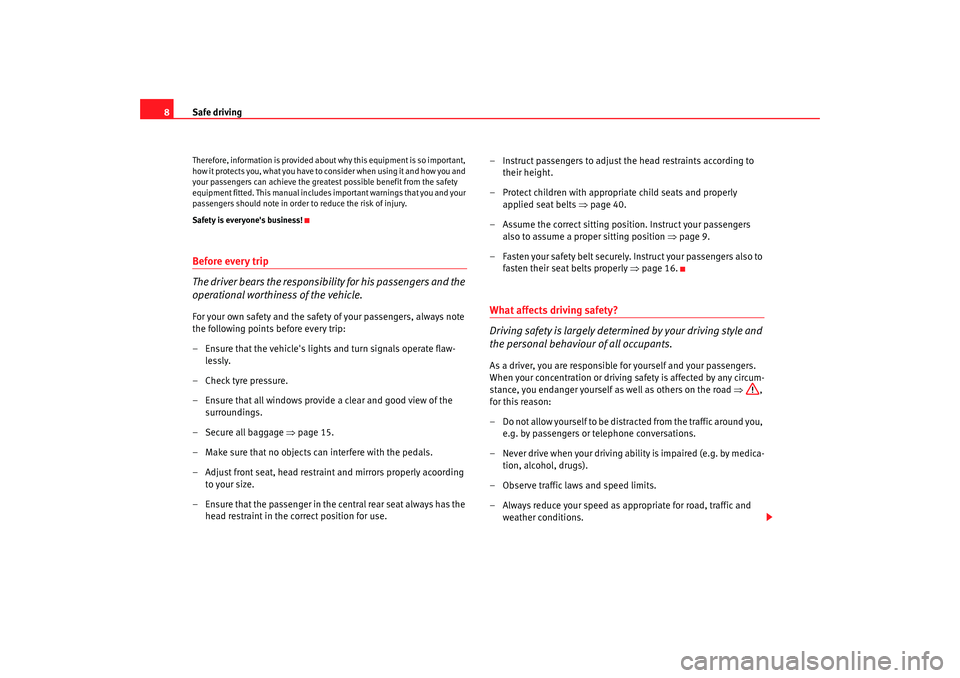
Safe driving
8Therefore, information is provided about why this equipment is so important,
how it protects you, what you have to consider when using it and how you and
your passengers can achieve the greatest possible benefit from the safety
equipment fitted. This manual includes important warnings that you and your
passengers should note in order to reduce the risk of injury.
Safety is everyone's business!Before every trip
The driver bears the responsibility for his passengers and the
operational worthiness of the vehicle.For your own safety and the safety of your passengers, always note
the following points before every trip:
– Ensure that the vehicle's lights and turn signals operate flaw- lessly.
– Check tyre pressure.
– Ensure that all windows provide a clear and good view of the surroundings.
– Secure all baggage ⇒page 15.
– Make sure that no objects can interfere with the pedals.
– Adjust front seat, head restraint and mirrors properly acoording to your size.
– Ensure that the passenger in the central rear seat always has the head restraint in the correct position for use. – Instruct passengers to adjust the head restraints according to
their height.
– Protect children with appropriate child seats and properly applied seat belts ⇒page 40.
– Assume the correct sitting position. Instruct your passengers also to assume a proper sitting position ⇒ page 9.
– Fasten your safety belt securely. Instruct your passengers also to fasten their seat belts properly ⇒page 16.
What affects driving safety?
Driving safety is largely determined by your driving style and
the personal behaviour of all occupants.As a driver, you are responsible for yourself and your passengers.
When your concentration or driving safety is affected by any circum-
stance, you endanger yourself as well as others on the road ⇒,
for this reason:
– Do not allow yourself to be distracted from the traffic around you, e.g. by passengers or telephone conversations.
– Never drive when your driving ability is impaired (e.g. by medica- tion, alcohol, drugs).
– Observe traffic laws and speed limits.
– Always reduce your speed as appropriate for road, traffic and weather conditions.
Ibiza250_angles Seite 8 Dienstag, 5. August 2008 1:11 13
Page 14 of 260
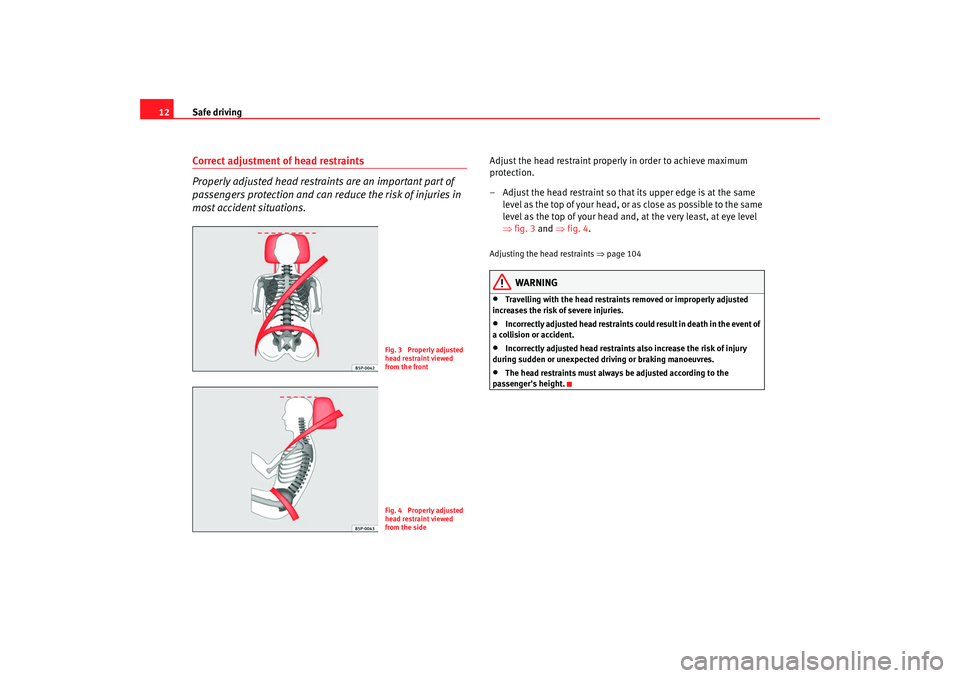
Safe driving
12Correct adjustment of head restraints
Properly adjusted head restraints are an important part of
passengers protection and can re duce the risk of injuries in
most accident situations.
Adjust the head restraint properly in order to achieve maximum
protection.
– Adjust the head restraint so that its upper edge is at the same
level as the top of your head, or as close as possible to the same
level as the top of your head and, at the very least, at eye level
⇒fig. 3 and ⇒ fig. 4.Adjusting the head restraints ⇒page 104
WARNING
•
Travelling with the head restraints removed or improperly adjusted
increases the risk of severe injuries.
•
Incorrectly adjusted head restraints could result in death in the event of
a collision or accident.
•
Incorrectly adjusted head restraints also increase the risk of injury
during sudden or unexpected driving or braking manoeuvres.
•
The head restraints must always be adjusted according to the
passenger's height.
Fig. 3 Properly adjusted
head restraint viewed
from the frontFig. 4 Properly adjusted
head restraint viewed
from the side
Ibiza250_angles Seite 12 Dienstag, 5. August 2008 1:11 13
Page 18 of 260
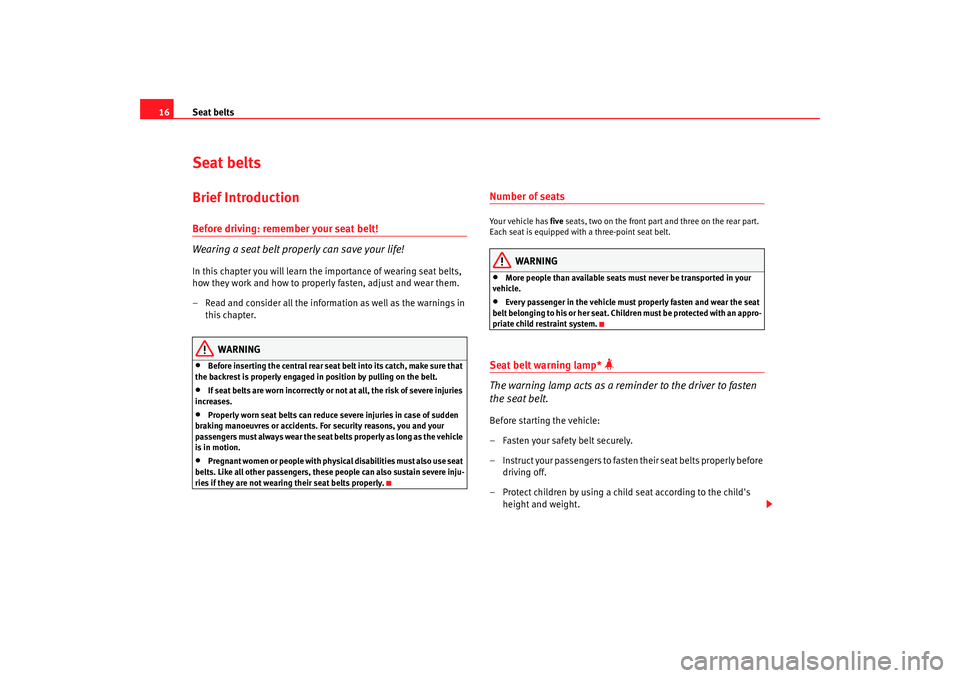
Seat belts
16Seat beltsBrief IntroductionBefore driving: remember your seat belt!
Wearing a seat belt properly can save your life!In this chapter you will learn the importance of wearing seat belts,
how they work and how to properly fasten, adjust and wear them.
– Read and consider all the information as well as the warnings in
this chapter.
WARNING
•
Before inserting the central rear seat belt into its catch, make sure that
the backrest is properly engaged in position by pulling on the belt.
•
If seat belts are worn incorrectly or no t at all, the risk of severe injuries
increases.
•
Properly worn seat belts can reduce severe injuries in case of sudden
braking manoeuvres or accidents. For security reasons, you and your
passengers must always wear the seat belts properly as long as the vehicle
is in motion.
•
Pregnant women or people with physica l disabilities must also use seat
belts. Like all other passengers, these people can also sustain severe inju-
ries if they are not wearing their seat belts properly.
Number of seatsYour vehicle has five seats, two on the front part and three on the rear part.
Each seat is equipped with a three-point seat belt.
WARNING
•
More people than available seats must never be transported in your
vehicle.
•
Every passenger in the vehicle must properly fasten and wear the seat
belt belonging to his or her seat. Children must be protected with an appro-
priate child restraint system.
Seat belt warning lamp*
The warning lamp acts as a reminder to the driver to fasten
the seat belt.Before starting the vehicle:
– Fasten your safety belt securely.
– Instruct your passengers to fasten their seat belts properly before driving off.
– Protect children by using a child seat according to the child's height and weight.
Ibiza250_angles Seite 16 Dienstag, 5. August 2008 1:11 13
Page 33 of 260
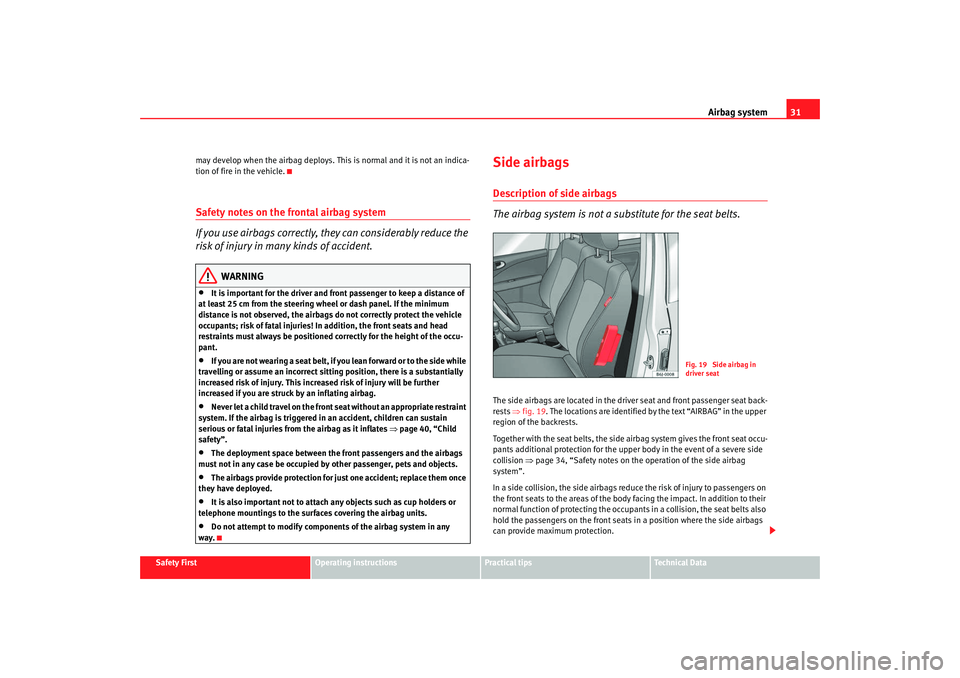
Airbag system31
Safety First
Operating instructions
Practical tips
Te c h n i c a l D a t a
may develop when the airbag deploys. This is normal and it is not an indica-
tion of fire in the vehicle.
Safety notes on the frontal airbag system
If you use airbags correctly, they can considerably reduce the
risk of injury in many kinds of accident.
WARNING
•
It is important for the driver and front passenger to keep a distance of
at least 25 cm from the steering wheel or dash panel. If the minimum
distance is not observed, the airbags do not correctly protect the vehicle
occupants; risk of fatal injuries! In addition, the front seats and head
restraints must always be positioned correctly for the height of the occu-
pant.
•
If you are not wearing a seat belt, if you lean forward or to the side while
travelling or assume an incorrect sitting position, there is a substantially
increased risk of injury. This increased risk of injury will be further
increased if you are struck by an inflating airbag.
•
Never let a child travel on the front seat without an appropriate restraint
system. If the airbag is triggered in an accident, children can sustain
serious or fatal injuries from the airbag as it inflates ⇒page 40, “Child
safety”.
•
The deployment space between the front passengers and the airbags
must not in any case be occupied by other passenger, pets and objects.
•
The airbags provide protection for just one accident; replace them once
they have deployed.
•
It is also important not to attach any objects such as cup holders or
telephone mountings to the surfaces covering the airbag units.
•
Do not attempt to modify components of the airbag system in any
way.
Side airbagsDescription of side airbags
The airbag system is not a substitute for the seat belts.The side airbags are located in the driver seat and front passenger seat back-
rests ⇒fig. 19 . The locations are identified by the text “AIRBAG” in the upper
region of the backrests.
Together with the seat belts, the side airbag system gives the front seat occu-
pants additional protection for the upper body in the event of a severe side
collision ⇒page 34, “Safety notes on the operation of the side airbag
system”.
In a side collision, the side airbags reduce the risk of injury to passengers on
the front seats to the areas of the body facing the impact. In addition to their
normal function of protecting the occupan ts in a collision, the seat belts also
hold the passengers on the front seats in a position where the side airbags
can provide maximum protection.
Fig. 19 Side airbag in
driver seat
Ibiza250_angles Seite 31 Dienstag, 5. August 2008 1:11 13
Page 42 of 260
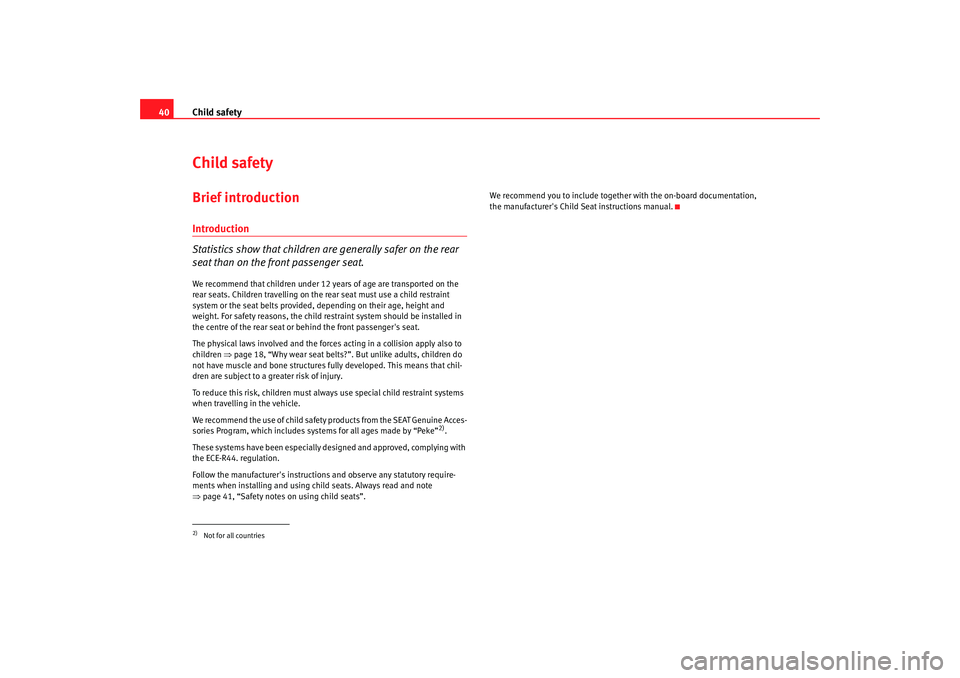
Child safety
40Child safetyBrief introductionIntroduction
Statistics show that children are generally safer on the rear
seat than on the front passenger seat.We recommend that children under 12 years of age are transported on the
rear seats. Children travelling on the rear seat must use a child restraint
system or the seat belts provided, depending on their age, height and
weight. For safety reasons, the child restraint system should be installed in
the centre of the rear seat or behind the front passenger's seat.
The physical laws involved and the forces acting in a collision apply also to
children ⇒page 18, “Why wear seat belts?”. But unlike adults, children do
not have muscle and bone structures fu lly developed. This means that chil-
dren are subject to a greater risk of injury.
To reduce this risk, children must always use special child restraint systems
when travelling in the vehicle.
We recommend the use of child safety products from the SEAT Genuine Acces-
sories Program, which includes systems for all ages made by “Peke”
2).
These systems have been especially designed and approved, complying with
the ECE-R44. regulation.
Follow the manufacturer's instructions and observe any statutory require-
ments when installing and using child seats. Always read and note
⇒ page 41, “Safety notes on using child seats”. We recommend you to include together
with the on-board documentation,
the manufacturer's Child Seat instructions manual.
2)Not for all countries
Ibiza250_angles Seite 40 Dienstag, 5. August 2008 1:11 13
Page 43 of 260
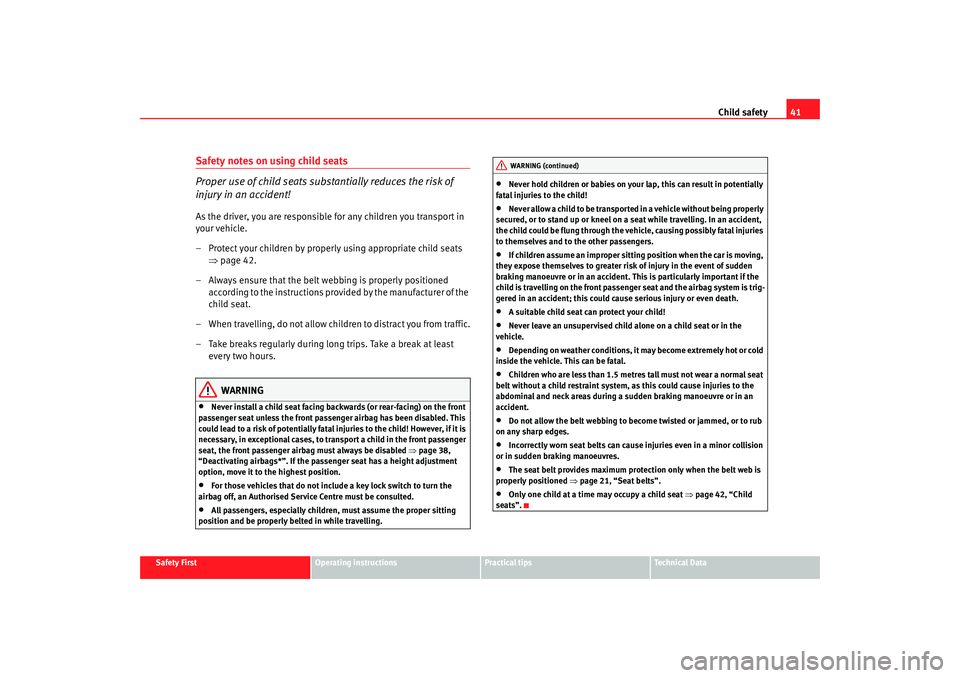
Child safety41
Safety First
Operating instructions
Practical tips
Te c h n i c a l D a t a
Safety notes on using child seats
Proper use of child seats substantially reduces the risk of
injury in an accident!As the driver, you are responsible for any children you transport in
your vehicle.
– Protect your children by properly using appropriate child seats
⇒page 42.
– Always ensure that the belt webbing is properly positioned according to the instructions prov ided by the manufacturer of the
child seat.
– When travelling, do not allow children to distract you from traffic.
– Take breaks regularly during long trips. Take a break at least every two hours.
WARNING
•
Never install a child seat facing backwards (or rear-facing) on the front
passenger seat unless the front passenger airbag has been disabled. This
could lead to a risk of pote ntially fatal injuries to the child! However, if it is
necessary, in exceptional cases, to transport a child in the front passenger
seat, the front passenger airbag must always be disabled ⇒page 38,
“Deactivating airbags*”. If the passe nger seat has a height adjustment
option, move it to the highest position.
•
For those vehicles that do not include a key lock switch to turn the
airbag off, an Authorised Service Centre must be consulted.
•
All passengers, especially children, must assume the proper sitting
position and be properly belted in while travelling.
•
Never hold children or babies on your lap, this can result in potentially
fatal injuries to the child!
•
Never allow a child to be transported in a vehicle without being properly
secured, or to stand up or kneel on a seat while travelling. In an accident,
the child could be flung through the vehicle, causing possibly fatal injuries
to themselves and to the other passengers.
•
If children assume an improper sitting position when the car is moving,
they expose themselves to greater risk of injury in the event of sudden
braking manoeuvre or in an accident. Th is is particularly important if the
child is travelling on the front passenger seat and the airbag system is trig-
gered in an accident; this could cause serious injury or even death.
•
A suitable child seat can protect your child!
•
Never leave an unsupervised child alone on a child seat or in the
vehicle.
•
Depending on weather conditions, it may become extremely hot or cold
inside the vehicle. This can be fatal.
•
Children who are less than 1.5 metres tall must not wear a normal seat
belt without a child restraint system, as this could cause injuries to the
abdominal and neck areas during a sudden braking manoeuvre or in an
accident.
•
Do not allow the belt webbing to become twisted or jammed, or to rub
on any sharp edges.
•
Incorrectly worn seat belts can cause injuries even in a minor collision
or in sudden braking manoeuvres.
•
The seat belt provides maximum protection only when the belt web is
properly positioned ⇒page 21, “Seat belts”.
•
Only one child at a time may occupy a child seat ⇒page 42, “Child
seats”.WARNING (continued)
Ibiza250_angles Seite 41 Dienstag, 5. August 2008 1:11 13
Page 106 of 260
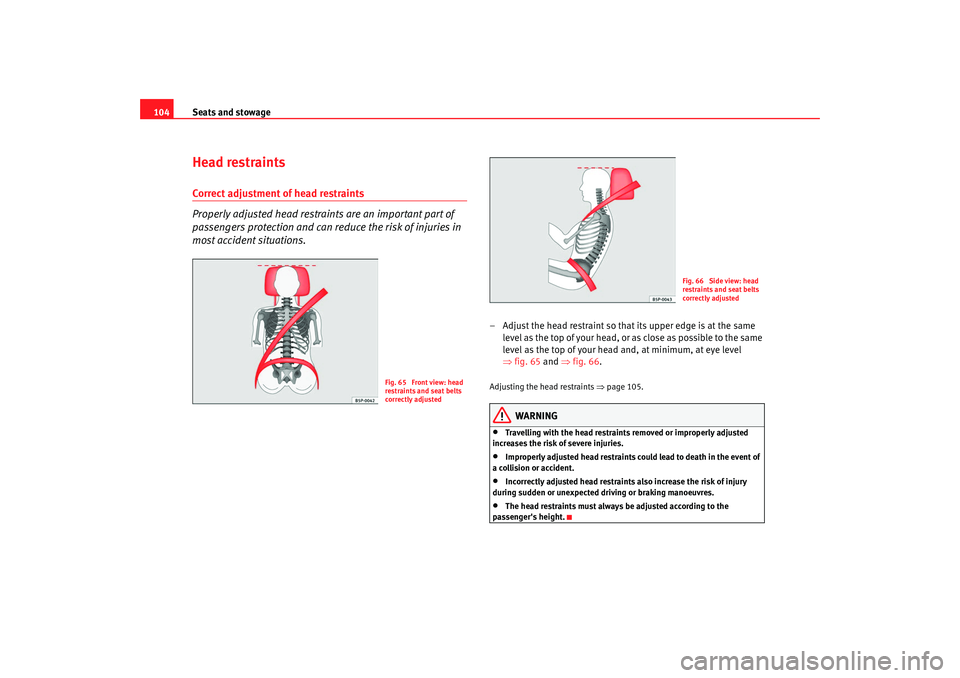
Seats and stowage
104Head restraintsCorrect adjustment of head restraints
Properly adjusted head restraints are an important part of
passengers protection and can re duce the risk of injuries in
most accident situations.
– Adjust the head restraint so that its upper edge is at the same
level as the top of your head, or as close as possible to the same
level as the top of your head and, at minimum, at eye level
⇒fig. 65 and ⇒fig. 66 .Adjusting the head restraints ⇒page 105.
WARNING
•
Travelling with the head restraints removed or improperly adjusted
increases the risk of severe injuries.
•
Improperly adjusted head restraints could lead to death in the event of
a collision or accident.
•
Incorrectly adjusted head restraints also increase the risk of injury
during sudden or unexpected driving or braking manoeuvres.
•
The head restraints must always be adjusted according to the
passenger's height.
Fig. 65 Front view: head
restraints and seat belts
correctly adjusted
Fig. 66 Side view: head
restraints and seat belts
correctly adjusted
Ibiza250_angles Seite 104 Dienstag, 5. August 2008 1:11 13